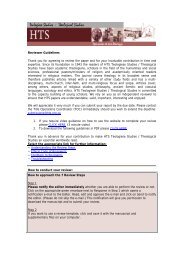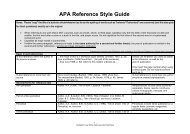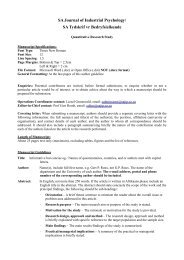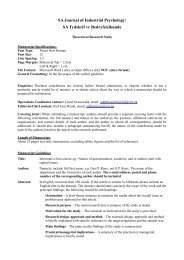Guideline for articles (Qualitative research)
Guideline for articles (Qualitative research)
Guideline for articles (Qualitative research)
Create successful ePaper yourself
Turn your PDF publications into a flip-book with our unique Google optimized e-Paper software.
SA Journal of Human Resource Management/<br />
SA Tydskrif vr Menslikehulpbronbestuur<br />
<strong>Qualitative</strong> Research Study<br />
Manuscript Specifications:<br />
Font Type: Times New Roman<br />
Font Size: 12<br />
Line Spacing: 1.5<br />
Page Margins: Bottom & Top = 2.5cm<br />
Left & Right = 2 cm<br />
File Format: Microsoft Word (.doc) or Open Office (.dot) NOT (.docx <strong>for</strong>mat)<br />
General Formatting: At the last pages of this author guideline<br />
Enquiries: Potential contributors are invited, be<strong>for</strong>e <strong>for</strong>mal submission, to enquire whether or not a particular<br />
article would be of interest, or to obtain advice about the way in which a manuscript should be prepared <strong>for</strong><br />
submission.<br />
Operations Coodinator contact: Liezel Grunewald, email: mailto:submissions@sajhrm.co.za<br />
Editor-in-Chief contact: Prof Gert Roodt, email: mailto:editor@sajhrm.co.za<br />
Covering letter: When submitting a manuscript, authors should provide a separate covering letter with the<br />
following in<strong>for</strong>mation: the full name(s) and title(s) of the author(s); the position, affiliation (university or<br />
organisation), and contact details of each author; and the author to whom all correspondence should be<br />
addressed. It should also include a paragraph summarising briefly the nature of the contribution made by each<br />
of the authors listed on the article to the <strong>research</strong> per<strong>for</strong>med.<br />
Length of Manuscript:<br />
About 25 pages text only (maximum), excluding tables, figures and the list of references.<br />
Manuscript <strong>Guideline</strong>s<br />
Title:<br />
Author:<br />
Abstract:<br />
In<strong>for</strong>mative but concise eg.: Names of questionnaires, countries, and or authors start with<br />
capital letters.<br />
Name(s), include full first name, e.g. Gert P. Roux, not G.P. Roux. The name of the<br />
department and the University of each author. The e-mail address, postal and phone<br />
number of the corresponding author should be included.<br />
In English, not more than 250 words. If the article is written in Afrikaans please include an<br />
English title in the abstract. The abstract should state concisely the scope of the work and the<br />
principal findings, the following should be sub-headings:<br />
· Orientation – A brief theme sentence to orientate the reader about the overall issue or<br />
problem area addressed in this article.<br />
· Research purpose – The main <strong>research</strong> aim or purpose of the study is stated.<br />
· Motivation <strong>for</strong> the study – The rationale or motivation <strong>for</strong> the study is provided.<br />
· Research design, approach and method – The <strong>research</strong> design, approach and method is<br />
briefly explained with specific reference to the target population and the sample size.<br />
· Main findings – The main results/findings of the study is summarized.
Key words:<br />
Synopsis:<br />
· Practical/managerial implications – A summary of the practical or managerial<br />
implications is briefly stated.<br />
· Contribution/value-add – A concluding statement indicates the contribution or value-add<br />
of the study in addressing gaps or contradictions in the literature.<br />
Use five [5] words not already included in the title, separated by a semi-colon. Refer to the<br />
discipline; sub-discipline; field; theme; <strong>research</strong> design; context<br />
Afrikaans <strong>articles</strong> (or <strong>articles</strong> in any other official SA language) must also have a synopsis of<br />
the article of between 500-600 words in English (the entire synopsis appears in italics).<br />
We also ask that you upload a brief biographical note (entered into the ‘Bio statement’ box during the<br />
submission process). This note will appear online in our ‘About the Author’ section should your article be<br />
published with us.<br />
Manuscript Contents<br />
The manuscript contains five sections, namely the introduction, <strong>research</strong> design, results, discussion and the<br />
references. All these first-level headings appear in bold capital letters and are centered.<br />
INTRODUCTION (first-level heading)<br />
The introductory section normally contains the following seven elements; headings are indicated in [brackets]:<br />
(1) [Key focus of the study] A thought-provoking introductory statement on the broad<br />
theme or topic of the <strong>research</strong> (why should I even bother to read further);<br />
(2) [Background to the study] Providing the background or the context to the study<br />
(explaining the role of other relevant key variables in this study);<br />
(3) [Research purpose] Indicate the most important controversies, gaps and<br />
inconsistencies in the literature to be addressed by this study;<br />
(4) [Trends from the <strong>research</strong> literature] Cite the most important published studies<br />
previously conducted on this topic or that has any relevance to this study (provide a<br />
high-level synopsis of the <strong>research</strong> literature on this topic);<br />
(5) In view of the above (in 4) state the core <strong>research</strong> problem and specific <strong>research</strong><br />
objectives that will be addressed in this study;<br />
(6) [The potential value-add of the study] Explanation of the study’s academic<br />
(theoretical & methodological) or practical merit and/or importance (provide the<br />
value-add and/or rationale <strong>for</strong> the study); and<br />
(7) [What will follow] Provide the reader with an outline of what to expect in the rest of<br />
the article.<br />
The first-level heading is INTRODUCTION. However, second-level headings may be used in this<br />
introductory section. These subheadings are flush with the margin, and are typed in lower case; bold starting<br />
with a capital letter. The INTRODUCTION section consists of an introduction to the article and a literature<br />
review.<br />
If lists of bullet points are presented, they should be in the following <strong>for</strong>mat:<br />
• Longevity. How long individuals live.<br />
• Prognosis. How well an individual responds to challenges of disease or trauma.<br />
• Mental health. General level of mental functioning
Avoid using lists that contain more than 10 bullet points.<br />
Synthesis and Critical evaluation of the literature<br />
A synthesis and critical evaluation of the literature (not a compilation of citations and references) should at<br />
least include or address the following aspects:<br />
(1) Conceptual (theoretical) definitions of all key concepts;<br />
(2) A critical review and summary of the themes emerging from previous <strong>research</strong> findings (constructs,<br />
<strong>research</strong> participants, <strong>research</strong> designs, objectives, etc.) on the topic;<br />
(3) Including a review of existing approaches towards the measurement of relevant constructs;<br />
and<br />
(4) A clearly established link exists between <strong>for</strong>mulated hypotheses (or objectives) and<br />
theoretical support from the relevant literature. The stated hypotheses follow directly on the<br />
section where the literature was reported.<br />
RESEARCH DESIGN (first-level heading)<br />
The first-level heading RESEARCH DESIGN is typed in capital letters, centered and in bold. Only three<br />
second-level headings follow on the <strong>research</strong> design and they appear in lower case, bold and are flush with the<br />
margin.<br />
Research approach (second-level heading)<br />
A brief description of the <strong>research</strong> approach followed in the study should be included. It should, <strong>for</strong> instance,<br />
explain from which qualitative tradition the study is and also motivate why this approach is specifically<br />
required. The author(s) may state their scientific beliefs (ontology and epistemology) if these have an effect on<br />
the choice of the <strong>research</strong> approach.<br />
Research strategy (second-level heading)<br />
<strong>Qualitative</strong> <strong>research</strong> makes in most instances use of the case study method where a single case or multiple<br />
cases are used either to develop or to test theory. The <strong>research</strong> case(s) should there<strong>for</strong>e be fully described here<br />
and which populations/ cohorts they present.<br />
Research method (second-level heading)<br />
Under the <strong>research</strong> method the author(s) provide at least descriptions on the following third-level headings,<br />
namely: <strong>research</strong> setting, entrée and establishing <strong>research</strong>er roles, sampling, data collection methods, recording<br />
of the data, data analyses, strategies employed to ensure data quality and reporting.<br />
These headings are typed in bold and are flush against the margin. Fourth-level headings (italics) may be used<br />
under each of these headings (as described above).<br />
Research setting (third-level heading)<br />
The author(s) provide a brief description of the <strong>research</strong> setting and unique characteristics of this setting in<br />
this section.<br />
Entrée and establishing <strong>research</strong>er roles (third-level heading)<br />
The author(s)/<strong>research</strong>ers explain how access was negotiated and/or obtained to enter the <strong>research</strong> setting (if<br />
not already part of the setting) and if and how gate-keepers were used to gain access to the <strong>research</strong> setting.
Sampling (third-level heading)<br />
The qualitative sampling procedures used in the study, such as cueing, purposive sampling or snow-balling are<br />
described and motivated in this section.<br />
Data collection methods (third-level heading)<br />
In this section the author(s) explain where the data was sourced and which data collection methods (e.g. semistructured<br />
or unstructured interviews, focus-groups) were applied. In some instances solicited documents are<br />
also used.<br />
Recording of data (third-level heading)<br />
The author(s) in this instance explain how the data was accurately recorded, safely stored and managed<br />
without compromising the quality of the data.<br />
Data analyses (third-level heading)<br />
In this case the author(s) explain which methods of data analyses were applied. Different data analyses<br />
techniques result in different variations of qualitative <strong>research</strong>.<br />
Strategies employed to ensure quality data (third-level heading)<br />
This sub-heading is optional here. Author(s) can explain how and why specific techniques are applied to<br />
ensure the integrity of the <strong>research</strong> data and <strong>for</strong> promoting the quality of the study. This can be either<br />
explained under all the sub-headings above or under this separate sub-heading. This is especially important if<br />
the authors are an integral part of the <strong>research</strong> setting.<br />
Reporting (third-level heading)<br />
Author(s) should also explain which reporting style (qualitative writing style) will be followed in reporting the<br />
<strong>research</strong> findings.<br />
FINDINGS (first-level heading)<br />
The next heading is FINDINGS, which appears in capital letters, bold and is centred. This section presents<br />
the results of the investigation in the sequence of the <strong>for</strong>mulated objectives or <strong>for</strong>mulated<br />
postulates/propositions (if applicable).<br />
DISCUSSION (first-level heading)<br />
The next heading is DICUSSION, which appears in capital letters, in bold and centred.<br />
This section normally contains the following eight elements:<br />
•restate the main objective of the study;<br />
•reaffirm the importance of the study by restating its main contributions;<br />
•summarise the results in relation to each stated <strong>research</strong> objective or <strong>research</strong> hypothesis;<br />
•link the findings back to the literature and to the results reported by other <strong>research</strong>ers;<br />
•provide explanations <strong>for</strong> unexpected results;<br />
•provide the conclusion and recommendations (implications <strong>for</strong> practice);<br />
•point out the possible limitations of the study; and<br />
•provide suggestions <strong>for</strong> future <strong>research</strong>.<br />
Second and third-level headings may be used.
REFERENCES (first-level heading)<br />
References begin on a separate page. References cited in the text should all be included in the list at the end of<br />
the paper. Full references at the end of the paper, arranged alphabetically by surname, chronologically within<br />
each name, with suffixes a, b, c, etc. to the year <strong>for</strong> more than one per year by the same author. Note that the<br />
second and subsequent lines are indented. This journal makes use of the APA reference style. We have an APA<br />
style guide which you can be download from the journal website.<br />
General Specifications of Manuscript<br />
Layout<br />
• The text should be 1.5-spaced.<br />
• Start each paragraph at the margin (no tabs to indent first line). Place a blank line between paragraphs<br />
to separate.<br />
Heading styles<br />
• First level headings: (Boldface, upper case, centred, on a separate line, 14pt)<br />
• Second level headings: (Boldface, normal case, justified at left margin, on a separate line, 12pt)<br />
• Third level headings: (Boldface, normal case, justified at left margin, on a separate line, 10pt)<br />
Citations in the text<br />
• In referring to a work by three, four or five authors all the relevant names have to be furnished in the<br />
first reference to the work, e.g.: …the traditionalist personality (Riesman, Denney & Glazer,<br />
1968, p. 40) restrains him from doing…<br />
In later references to this work only the first author’s name is stated, and the abbreviation ‘et al.’<br />
is used: …due to his “other-directness” modern Western man in a sense is at home everywhere and<br />
yet nowhere (Riesman et al., 1968, p. 40)…<br />
• In referring to a work by six or more authors, cite only the surname of the first author followed by et<br />
al. (italicized and with a full stop after “al”), and the year <strong>for</strong> the first and subsequent citations. In<br />
the reference list, provide the initials and surnames of the first six authors, and shorten any<br />
remaining authors to et al.<br />
• When titles of journals or books are mentioned, they should be italicised, not underlined.<br />
• If the citation follows a quotation, place the parentheses after the quotation marks but be<strong>for</strong>e the end<br />
punctuation. For example: ’<strong>for</strong> the future of telecommunications’ (Smith 1987).<br />
• Single quotation marks are used <strong>for</strong> all quotations; to highlight a quote within a quote, please use<br />
double quotation marks. If citations are longer than 30 words, please do not use single quotation<br />
marks; rather indent the citation and italicise it, positioning parentheses containing the author(s),<br />
year and page numbers of the publication cited on the line after the citation, right aligned.<br />
Tables and figures<br />
In Step 4, upload all tables, figures, images, and supplementary files:<br />
• Tables should be saved and uploaded as separate Word (.doc) or RTF (.rtf) files, not DOCX (.docx).<br />
• Ensure all personal identifying in<strong>for</strong>mation is removed from the supplementary files as per the<br />
provided instructions. Please note that this is not required <strong>for</strong> book reviews.<br />
• Figures and images should be saved and uploaded using high quality image <strong>for</strong>mats: BMP, TIFF, EPS,<br />
JPEG (uncompressed); not GIF or compressed JPEG.<br />
• Audio and video files should be saved and uploaded using the MPEG <strong>for</strong>mat (MP3 <strong>for</strong> audio and<br />
MPEG <strong>for</strong> video).<br />
Acronyms: If a phrase with an established acronym is used (eg SAN Parks – South African National Parks),
and appears more than five times, please include the acronym in brackets after first mention of the phrase, then<br />
use the acronym only. Please note that acronyms should not be used in abstracts.<br />
Units: The use of units should con<strong>for</strong>m to the SI convention and be abbreviated accordingly. Metric units and<br />
their international symbols are used throughout, as in the decimal point (not the decimal comma), and the 24-<br />
hour clock.<br />
Spacing and punctuation: There should be one space (not two) between sentences; one space be<strong>for</strong>e unit<br />
terms (e.g. 5 kg, 5 cm, 5 mmol, 5 days); no space be<strong>for</strong>e % or °. Thousand/millions are marked with a space,<br />
not a comma (e.g. 1 000, 1 000 000) Ranges are expressed with an extended hyphen, not with a short hyphen.<br />
Dates, italics, and spelling: Dates are written in the following style: 12 July 1908. Phrases within the text that<br />
are not English (<strong>for</strong> example, et al.) should be italicised. British (not the American) spelling convention is<br />
followed, <strong>for</strong> example organisation, not organization.<br />
Permission:<br />
Permission should be obtained from the author and publisher <strong>for</strong> the use of quotes, illustrations, tables and<br />
other materials taken from previously published works that are not in the public domain. The author is<br />
responsible <strong>for</strong> the payment of any copyright fee(s) if these have not been waived. The letters of permission<br />
should accompany the manuscript. The original source(s) should be mentioned in the figure legend or as a<br />
footnote to a table.<br />
Submissions and correspondence<br />
All submissions must be made online at http://www.sajhrm.co.za/and correspondence regarding manuscripts<br />
should be addressed to:<br />
The Editor, SAJHRM. E-mail: mailto:editor@sajhrm.co.za<br />
Note: Ensure that the article ID [reference] number is included in the subject of your email correspondence.


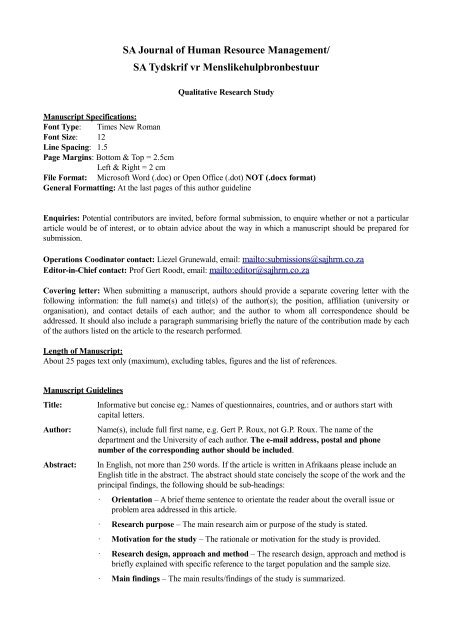
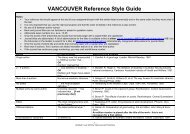
![Reference Style Guide [17-09-2008 Tdv].pdf](https://img.yumpu.com/42195443/1/184x260/reference-style-guide-17-09-2008-tdvpdf.jpg?quality=85)
